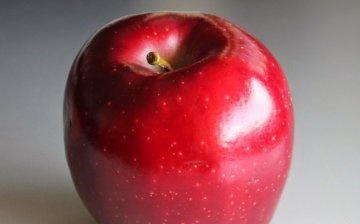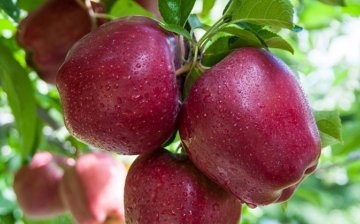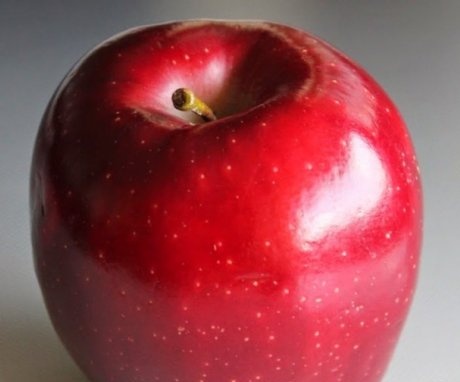Review of the Delicious apple variety and its main features
Apples contain many useful substances that are valuable for the human body.
It is believed that in order to obtain a large harvest of these fruits, it is enough to choose the right variety. However, each type of culture has a number of features, without taking into account which the tree will not bear fruit generously.
The article discusses the agricultural technology of the popular Delicious apple variety.
Features of the variety
It is quite easy to recognize apples of this variety in the garden by the characteristic features inherent exclusively in Delicious.
A brief history of origin, where they grow
There is no exact data on how Delicious was bred. It is believed that the apple variety was formed as a result of random pollination of different varieties and a mutation process. The home of delicious-tasting apples is South Virginia (America).
Characteristics of trees, shoots, foliage, fruits
The shape of the tree changes depending on the stages of life. The young plant resembles an inverted pyramid in appearance; in the fruiting period it becomes rounded. The apple tree develops intensively, growing branches from the trunk at an acute angle. Near the base, the shoots are slightly bent. The bark is dark gray, medium thickness. Fruiting of the Delicious variety is mixed. Fruit twigs and spears predominate.
Brief description of the shoots:
- dark red tint;
- average length and thickness;
- there is a weak edge;
- along the entire length there are small lentils (in the part that is located closer to the base, they are located in groups);
- bends are moderately geniculate.
The leaves have a wide-oval shape, occasionally there are trees with oblong-ovoid greenery. The edges are framed with a double-toothed cut. A slight bending of the plate is observed. The foliage color is dark green with a transition to a light tone closer to the petiole. The edge is barely noticeable.
The surface of the plate is slightly glossy. The long petiole is colored red to the base or along the entire length. Stipules are lanceolate of medium size.
The inflorescences are characterized by large parameters, the shape resembles a bowl, the color of the petals is pink. The buds themselves are red. A column of pistils is visible in the center. They are long and edged. The stigmas are located at or below the anthers.
Description of fruits:
- sizes (with proper care) - large;
- shape - oblong-conical, ribbing is visible;
- there are 5 distinct tubercles around the saucer;
- apple diameters vary along its entire length, especially in the lower part;
- the skin is dense, smooth, on the surface there are subcutaneous white dots and gray protrusions;
- the color of the fruit is light green (as it reaches full ripeness, the color turns yellow), Red Delicious apples are of a deep dark red color;
- the pulp is white with a green tint (during storage it turns yellow), the structure is dense;
- palatability - pleasant aroma, sweet note with barely noticeable sourness, a lot of juice.
Reference! The result of improper care of the apple tree is a changed taste, which acquires freshness and bitterness. Fruits are rarely poured to standard sizes.
The apples are removed from the tree at the end of September. When favorable conditions are created, the harvest is stored until March and even April. The yield per hectare is 130-190 centners. Fruiting periodically with mild variability.
The weak point of the variety is the tendency to be affected by scab.
Composition and useful properties of fruits
Despite the fact that the fruit consists mainly of water (more than 50%), it contains a large amount of chemical elements valuable for the human body. Among them:
- potassium;
- magnesium;
- iron;
- phosphorus;
- sodium;
- manganese;
- fluorine;
- zinc, etc.
In addition, the pulp is saturated with vitamins of different groups: C, A, PP, B9, B6, B5. Carotene, which is part of the fruit, has a beneficial effect on nails and hair, visual function and bone tissue. Ascorbic acid helps to strengthen the protective function, which helps to resist viruses and infections. Iodine improves thyroid function.
|
Composition of Delicious apples |
|
|
Name |
Volume per 100 g |
|
Ascorbic acid |
5.2-10.0 mg |
|
P-active substances |
140 mg |
|
Pectins |
0.7 mg dry weight |
|
Sugar |
11-13% |
|
Titratable acids |
0,25% |
Regular inclusion of apples on the menu helps to lower blood cholesterol levels. This prevents the development of clogged veins, helps cleanse blood vessels, and has a beneficial effect on the functionality of the cardiovascular system. The beneficial properties of the fruit are preserved for a long time.
Reference! The antioxidants taken by the apple stimulate blood flow to the gums. Malic acid has a destructive effect on plaque.
Doctors advise to include the product in any form in the menu for diseases of the kidneys, liver and heart. The high fiber content helps cleanse the intestines of toxins and waste products. Iron normalizes the level of hemoglobin in the blood. Apple tea relieves nervous tension well.
Taste qualities
The incredible aroma is combined with the sweet taste of the pulp. The dense structure does not cause discomfort when eating the fruit due to the increased juice content. A feature of the variety is the fact that during the storage of apples, their taste characteristics only improve.
Yield
Up to 300 centners of apples are harvested from 1 hectare when the trees reach 7-8 years of age. One tree 6-7 years old gives an average of 70-79 kg of fruit. The weight of the gifts of nature depends on the size of the apple itself. In difficult climatic regions, they are small. With proper care and favorable weather conditions, the fruit is intensively poured up to 10 cm in diameter.
Early maturity
Delicious refers to varieties with an average ripening period. Harvesting takes place from mid-September to the end of the same month. Every year there is an increase in the fertility of a young tree.
Record harvests are observed upon reaching 6-8 years of age. After 10 years of life, the regularity of fruiting is interrupted. You can get a high yield after one or several seasons.
The variety in question is fast-growing. The first fruits appear on a young tree after 3 years. With perfect care, the period is reduced to 2 years.
Reference! The parameters of fruits and yield are influenced not only by care, but also by weather conditions. In regions with a cool climate, the size of apples is significantly less than the standard, and the taste has a freshish tinge.
The timing of flowering, fruiting and storage of apples
Delicious blooms in late May - early June. The flowering period is protracted. You can also see pink inflorescences on planted seedlings, but the tree can only give fruits after 2-3 seasons.
Fruiting begins in the second decade of September. The harvesting process lasts until the end of the month. Each fruit should be carefully inspected before being stored. For long-term maintenance of apples, only those that do not show signs of disease or damage are selected. The presence of a stalk is encouraged.
Fruits with dents, wounds and other damage are immediately sent for processing. They are not suitable for storage.
They keep the harvest in a cellar or other utility room, where a stable temperature regime is set from 0 +4 degrees. In this case, the humidity indicator should be within 85-90%. Dry air makes apples wither.
Apples of different varieties are stored in separate containers.Fruits should be placed in boxes in one or a maximum of 4 layers. To prevent the spread of rot, it is recommended to wrap each fruit in newspaper or wrapping paper. Paper sheets are also stacked between the layers.
Growing features
The agricultural technology of the Delicious apple tree does not differ significantly from the rules for caring for fruit plants.
Landing
The planting of a seedling is planned for the spring. This must be done before the leaves bloom. If the buds swell on the tree, the risk that the plant will not take root increases. Seedlings in containers can be planted at a later date.
The place for the apple tree is chosen on an area with a low groundwater table (at least 2 m). Other criteria include good lighting, sandy or loamy soil.
It is better to dig a hole under the seedling in advance. Its parameters:
- depth - from 80 cm;
- width - from 1 m.
At the bottom, drainage is first introduced, after which a substrate from compost, fertilizers and leafy earth. Before planting, seedlings with an open root system are soaked for a couple of hours in a solution of water and a growth stimulator. Meanwhile, 1-2 buckets of warm water are poured into the pit and allowed to be completely absorbed.
The roots are gently immersed in a moist substrate and sprinkled with earth. The soil needs to be compacted a little so that the tree does not tilt after the soil dries out. Planting is completed by watering the trunk circle and backfilling it with mulch. When planting several seedlings, an interval of 4 meters is left between them.
Care
Experts say that it takes 20-25 days for a seedling to adapt to a new location. Plant survival is more dependent on regular irrigation and timely pruning.
When watering, water should penetrate deep into the soil up to 35-45 cm. One tree takes at least 10 liters of liquid. During the first month after planting, the apple tree is watered twice a week. Further, the regime provides for a reduction in the frequency of humidification to 1 time per week. In dry weather, the procedure is performed every other day, increasing the volume of water to 1.5-2 buckets.
After planting the seedling, pruning is done. The entire tip is removed so that only 40-45 cm of the shoot remains. At the end of each season, cut off dry branches, fattening and damaged shoots. As the plant grows, thinning and crown formation is carried out.
So that the soil does not dry out in hot weather, after watering, the soil surface in the near-trunk circle is lined with mulch. The following materials are used as mulch: peat, sawdust, straw, artificial mulch. The cover layer should be at least 7-10 cm.
From time to time there is a need to loosen the soil. At the same time weeding is performed. For the normal development of the root system, oxygen and the absence of moisture stagnation are important. This is ensured by regular aeration.
Resistant to temperatures
Delicious does not tolerate not only drought, but also low temperatures. A tree without shelter and protection may not survive winter with severe frosts. If during the flowering period the air cools down to -1 ° and below, fruiting in the season simply will not begin.
To diseases and pests
Like most apple varieties, Delicious is prone to common diseases. In wet weather, powdery mildew and scab are often attacked. To preserve the tree, it is recommended to carry out processing. For this, the plant is sprayed with a solution of colloidal sulfur and copper oxide. The same funds are used for preventive purposes.
Harmful insects also create problems during cultivation. Leafworms especially bother the apple tree. When signs of the presence of a parasite are detected, the plant is treated with nitrophen 3%. In the fight against aphids and mites, it is advisable to use karbofos.
The nuances of growing in different regions
Residents of different regions want to grow delicious apples on their plots. There are known facts of successful cultivation of Delicious in the Moscow region, the Volga region, Belarus, Ukraine.It is more difficult to preserve the viability of apple trees in the northwestern regions of Russia, because the variety belongs to thermophilic crops.
Reference! Other varieties have similar characteristics to Delicious. For example, Golden Rangers or Golden Delicious. They are frost-resistant, which allows them to survive harsh winters.
When landing Delicious in the regions of the Urals, it is recommended to adhere to the following rules:
- The trunk of the plant must be wrapped in expanded polystyrene, which is intended for insulation of pipelines.
- The crown should be formed so that the tree grows branches in breadth, and not in height.
- To prevent debris from the trunk under the influence of strong winds, a block should be driven next to the tree, which will serve as a support.
- They should be tied together with a string.
Spruce branches, agrofibre and other materials are suitable as a shelter for a tree. The soil in the near-trunk circle must be covered with a thick layer of dry leaves, peat, sawdust, on top of which earth is poured.
Possible problems with the variety and ways to solve them
When growing Delicious, the following difficulties may arise.
- Withering of young trees - occurs due to insufficient watering or lack of fertilizing. The situation can be corrected by carrying out activities in accordance with the rules of agricultural technology.
- Poor tree growth - you need to buy seedlings on low-growing and medium-sized rootstocks. Also, the reason may lie in the close occurrence of groundwater. Then a transplant will be required.
- The apple tree does not shed its foliage for the winter - this is found with abundant watering of the plant in the fall and the introduction of nitrogen fertilizers during this period. The problem can be prevented by correctly introducing the apple tree into a dormant state (infrequent watering after the end of the fruiting period, pruning, cleansing the trunk circle).
- Lack of fruit - either the apple tree is young, or pollinators do not grow nearby. The same effect is observed with old trees.
- Exfoliation of the bark - sunburn, freezing or bark beetle can provoke a problem. Solutions: spring and autumn whitewashing of the lower part of the trunk with lime, treatment with fungicides or insecticides.
Advantages and disadvantages of the variety
Delicious is incredibly popular with gardeners, due to the following advantages of culture:
- high tasting score of fruits;
- stable yield;
- marketable condition;
- long shelf life without loss of taste;
- excellent transportability.
The variety also has disadvantages:
- violation of stable productivity in adult plants;
- to get large fruits, you need to take care of creating the right conditions;
- susceptibility to powdery mildew;
- low frost resistance.
Pollinating varieties
The fertility of an apple tree of the variety in question can be assessed only if there is a neighborhood with pollinators. This is explained by the fact that the plant belongs to the self-infertile type. The following varieties are suitable for Delicious: Melrose, Jonathan, Idared, Gloucester, Elstar.
Reference! In self-infertile varieties of the total number of inflorescences, only 1-4% of flowers turn out to be capable of tying. It is simply impossible to get a good harvest without pollination.
The planting of pollinators should be done at a distance of 4-6 meters. It is recommended to choose 2-3 varieties as pollinating plants. When choosing options, consider:
- flowering periods (they must match);
- the life cycle of crops (approximately the same for pollinators and a pollinated apple tree);
- the main phases of development (should fall on one time period).
If difficulties arise when choosing varieties, it is recommended to seek help from specialists.
Testimonials
- Ivan Nikolaevich, Rostov region
I have been growing Delicious in the garden for over 9 years. The first fruits appeared on the tree in the 4th year after planting. For the next two seasons, the harvest was poor, not exceeding 2-4 apples. Then I learned from a neighbor that the variety is self-fertile.
I planted 2 Melrose seedlings nearby. Each year, the fruit grew more and more.After the seventh season, I removed 75 kg from the tree. This season I made a clothespin from Delicious to Eder. I'm waiting for the results.
- Elena, Moscow region
Several years ago I bought a summer cottage. There were already trees on it. Delicious apples ripened in September. On a low plant, the fruits literally stick to fragile branches. The crop weighed about 30 kg. Their taste pleasantly surprised me and all family members. Already next fall, I planted 2 seedlings of this variety. I also bought Idared for pollination.
Video review of the variety:












I love this variety, very tasty apples. And in our country house, no matter how many grandmother tried to plant apple trees, none of them took root, what varieties she just didn’t buy. Neighbors don't either. Rumor has it that the groundwater is close and the roots are rotting. Eh ...
I am Delicious blocks, very tasty. Due to the content of ascorbic acid in them, they are well stored. We put apples in a row in wooden boxes and store them in the basement. Apples are stored until April and only a few fruits spoil.
I like blocks of this type more than others. But attempts to grow such an apple tree on the site have not yet yielded results, although I seem to buy seedlings in a fairly reliable place. You have to buy apples, in the season it is not too expensive.